Tuesday, November 07, 2006
Interactives Maps
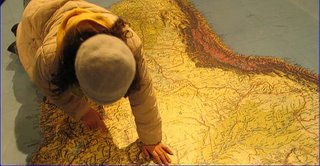 British researchers are developing a technology that will allow phone users (with a camera) to take a picture of any map and receive back an interactive version of the same map on their handset.
British researchers are developing a technology that will allow phone users (with a camera) to take a picture of any map and receive back an interactive version of the same map on their handset.It's enough to have a city-map provided by the tourism office, or displayed near the metro station, or in the Michelin, or .. ok, got it.
The system Map Snapper returns a map with clickable icons for restaurants, hotels, festivals, sausage-fairs, miss-universe elections, etc. With more photos, informations and a link to the website, eventually.
The phone sends a photo of a portion of the map to a central server that uses the image to generate a unique signature for that area of the map and then searches matches in a database of signatures.
The persons in charge for the project also envisaged to allow users to generate their own content for maps using an online interface, but we still didn't understand this one.
The wire also says that they are conscious that the technology could become obsolete shortly with the emergence of cell phones featuring GPS receivers.
Well done, guys ;)
NewScientistTech, last week.
Labels: gadgets
Wednesday, October 11, 2006
My passenger is a penguin
| Pioneer presented, during the Ceatec 2006, a new gizmo, a typically japanese stuff. It's a small electronic penguin that becomes your friend on the road. You put it on the dashboard of your car, just in front of you. Equipped with a small cam in the head, it recognizes you when you enter the car. Equipped with small wings, it moves them when the situation is hard on the road. Equipped with a speaker, it can talk to you and calm you down when everything's all right. Equipped with a very sensitive sense of obedience, it thunders you when you drive badly... |
Source: PC watch, last week.
For those who do not know: CEATEC JAPAN (exposition of merged high technologies) is the biggest worldwide exposition in Asia in technology and electronic, imagery, information, and communications.
Labels: gadgets
Friday, August 04, 2006
Control the PC with the finger
 In an attempt to cross the gigantic ravine still existing between the human capacities and those of the computer, researchers of the University of Buffalo developed a technology that enables computers to read the gestures of human hands.
In an attempt to cross the gigantic ravine still existing between the human capacities and those of the computer, researchers of the University of Buffalo developed a technology that enables computers to read the gestures of human hands. The Fingertip Digitizer, a device that you wear on the tip of your index finger. Then you can point or tap on the table, on the screen, draw large circles... everything is translated to the computer. Like a mouse or a joystick but with more freedom and accuracy, according to the above-named researchers.
They modelled the Digitizer according to the biomechanical attributes of the human finger, in order to be able to intuitively feel an object's properties. To detect movement and touch, it uses a force sensor, an accelerometer and a motion tracker. It measures the force feedback of the touched object and calculates the hand gestures following its acceleration and location.
Source: vnunet.com, Monday.
For those who do not know: The motion tracking is the identification of a shape by a software, and the location of the evolution image by image of this shape in the time, in order to create a movement.
Labels: gadgets
The most over-designed soda machine in the world
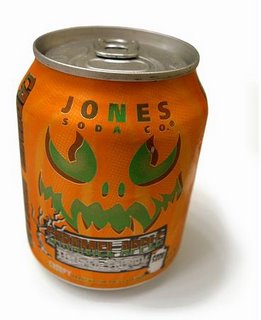
For the moment, the machine includes a barcode scanner, a fingerprint reader, and a web cam for facial recognition.
A coke? Place your beautiful head on the distributor so it can recognize you, check that you created an account. Take your drink and goodbye. No need of money or any card.
The project is called SodaVision and is still under development. Professor Stefan Savage tells: "The biggest problem was to write the purchase request for a 'biometric soda machine'. At the beginning, one looked at me oddly”. You astonish me.
The computer science department has had for 20 years a snack cooperative called "Chez Bob". With 50 cents, you could come and buy a drink. 10 years ago, somebody had the idea to create an account: it became necessary to log Chez Bob in order to buy a drink and then your account was debited. Since better had to be done, Savage launched the idea as an academic project.
The students conceived the interface, bought the material, wrote the software, even the facial recognition, which turns on Linux on a Celeron 2GHz, a processor which does not heat too much the Cokes.
Currently, the facial recognition is in the course of improvement, it reaches an accuracy of 80%, the goal being 95%. Fingerprints are here to help, and candy bars or other snack items are scanned with the barcode reader to debite the exact price.
Source: ContactlessNews, Monday.
Labels: gadgets
Friday, June 30, 2006
Intelligent touch-screen....
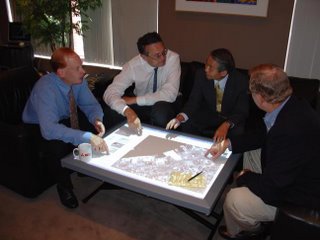 Researchers at the MERL (Mitsubishi Electric Research Laboratories) developed an interactive screen computer which is able to differentiate its multiple users and to keep a log of their activities.
Researchers at the MERL (Mitsubishi Electric Research Laboratories) developed an interactive screen computer which is able to differentiate its multiple users and to keep a log of their activities. Let's do it simply:
A touch screen, we see what it is: at the bank, at the station, using a navigation system... we interact with the computer by touching the screen with the finger.
A multi-touch screen is more rare, but a video demonstration ran on the Internet. It's the same, except that we can use many fingers and then, we could use it together.
We talk about that kind of screen, but this one can identify its users.
How? When somebody uses the screen, this one sends a negligible electric signal through the user's body. This signal is detected by a sensor on his seat. Hop, identified. And same thing for every user.
Why? Bah, video games or applications for meetings with security access. But just take another seat...
Source : the NewScientistTest, one month ago.
Labels: gadgets
Tuesday, June 27, 2006
The tracking USB stick
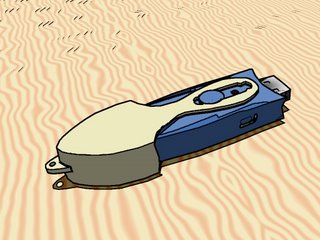 Track Stick is a small USB stick USB that holds in the pocket. Keep it with you all the time and it will record places, time, dates, speeds, directions and altitudes at regular frequency. With more than 1 Mb of memory, it can record several months of your life.
Track Stick is a small USB stick USB that holds in the pocket. Keep it with you all the time and it will record places, time, dates, speeds, directions and altitudes at regular frequency. With more than 1 Mb of memory, it can record several months of your life.Track Stick receives the signals of 24 satellites. With this information, it can precisely compute its position (and then yours) everywhere on the planet with an accuracy of 15 meters. It can also calculate how long you stay inside, i.e. when it does not receive any GPS signal.
You didn't need it? TrackStick dit it, and now you want it :/
Moreover, the history can be exported to these formats…
- RTF
- HTML : (really) beautiful pages with graphics and google maps
- CSV : columns separated with a comma, can be exported to Excel
- and overall KML, the file's format of Google Earth !
Labels: gadgets
Monday, June 26, 2006
Iris scanner for mobile phones

We can read on the xvista's website that this British company invented a technology of scan and recognition of the iris, able to run on embedded systems like cell phones or pocket PC, eventually equipped with a camera.
Labels: gadgets
Friday, June 16, 2006
A police film gadget

In the 'gadgets' section, but not for anyone .. for the police. This gadget, we all thought it was existing since hundred years, maybe a dream of kid. And it looks like we were wrong.
The website StarChase presents GPS transmitters to be stuck on the car of the gangster.
Arguing on the danger that represent the races on highways, StarChase seems to propose the all stuff: the machine to launch the transmitter, the transmitter itself and maybe the localization tools.
The video is quite long, so here is a link. And if you're in a hurry, go directly to 1 min 18 : there is the demo.
Labels: gadgets
Wednesday, June 07, 2006
clothing of the chameleon
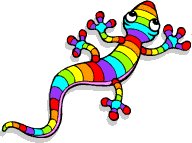
Researchers at the university of Storrs (Connecticut) used the electrospinning process to create long electrochemical polymers...Well, let's do shorter : researchers manufactured with changing colours.
Greg Sotzing, who seems to be the chief, explains that they have created a 1 kilometer long fibre that changes colour when they apply a different electrical voltage (red to blue, orange to blue). It's washable and a mix of different colours can be bent in a T-shirt, a shirt, a cover, ... that must also contain thing metal wires connected to a battery and a micro-controller. Hey hey !
All the small intermingled wires divide clothing into pixels, whose user could change the colour according to its tastes and its moods. Greg even imagines connecting the system to a camera and thus, clothing would match the colour of their environment. Here is a quite useful trick.
In 2003 already, BusinessWeek wrote an article on Dupont and the EIC laboratories which worked on camouflage for the US army. Howevere, the process was not the same one.
For the occasion, here is an article about a clothing that makes you invisible. It happens in Japan, why am I not surprised ?
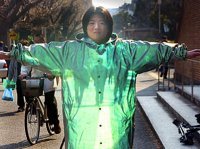 The picture is impressive but you should know that it was taken through a special lens, otherwise it does not work at all. It's limited, but can be used also for the army.
The picture is impressive but you should know that it was taken through a special lens, otherwise it does not work at all. It's limited, but can be used also for the army.Worst! There is a camera behind the guy, a camera that sends the picture from the back to the front, thanks to a spotlight and a reflecting surface.
source : NewScientist, april.
for those who do not know :
- a pixel is one of the many tiny dots that make up the representation of a picture in a computer's memory. Each such information element is not really a dot, nor a square, but an abstract sample.
- Electrospinning is a process by which fibers are drawn out from a viscous polymer/composite/sol-gel solution or melt by applying an electric field to a droplet of the solution (most often at a metallic needle tip).
Labels: gadgets
archives >> April - March - February - January -December - November - October - September - August - July - June - May
